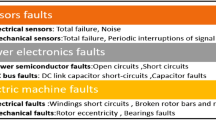Abstract
This paper presents the development of linearized model of asymmetrical six-phase grid-connected induction generator (GCIG) for small-signal stability. The developed linearized model has been used to obtain the eigenvalue to evaluate generator stability with respect to parameter variation of the machine in comparison with its three-phase counterpart. During the analysis, suitability of six-phase induction generator for higher output power has been accessed. Instability tendency during low electrical output power can be avoided through closed loop operation of the machine. Hence, the indirect field-oriented control scheme for asymmetrical six-phase GCIG has been proposed for stable operation with higher reliability. The key analytical results have been demonstrated with its experimental validation.














Similar content being viewed by others
References
Khan BH (2009) Non-conventional energy resources. Tata McGraw Hill, New Delhi
International Renewable Energy Agency (2020) https://irena.org/wind (accessed 5 May 2020)
Bose BK (2002) Modern power electronics and AC drives. Prentice Hall, NJ, Upper Saddle River
Zappalá D, Sarma N, Djurović S, Crabtreea CJ, Mohammad A, Tavnera PJ (2019) Electrical and mechanical diagnostic indicators of wind turbine induction generator rotor faults. Renew Energy 131:14–24
Xiea D, Lua Y, Suna J, Gu C (2017) Small signal stability analysis for different types of PMSGs connected to the grid. Renew. Energy 106:149–164
Singh GK (2002) Multi-phase induction machine drive research survey. Electr Power Syst Res 61:139–147
Chinmaya KA, Singh GK (2018) Performance evaluation of multiphase induction generator in stand-alone and grid connected wind energy conversion system. IET Renew Power Gen 12:823–883. https://doi.org/10.1049/iet-rpg.2017.0791
Singh GK (2011) Modeling and analysis of six-phase synchronous generator for stand-alone renewable energy generation. Energy 36:5621–5631. https://doi.org/10.1016/j.energy.2011.07.005
Singh GK (2008) Modeling and experimental analysis of a self-excited six-phase induction generator for stand-alone renewable energy generation. Renew Energy 33:1605–1621. https://doi.org/10.1016/j.renene.2007.08.007
Kumar AS, Munda JL, Singh GK (2015) Wind-driven stand-alone six-phase self-excited induction generator transients under different loading conditions. Electr Eng 97:87–100. https://doi.org/10.1007/s00202-014-0318-x
Khan MF, Khan MR, Iqbal A (2018) Modeling, implementation and analysis of a high (six) phase self excited induction generator. J Elec Sys Info Tech 5:794–812. https://doi.org/10.1016/j.jesit.2016.12.016
Mohanty AK, Yadav KB (2017) Performance characteristics of six-phase induction generator for Renewable Power Generation. Indo J Elec Eng Comp Sci 5:299–308
Singh GK, Kumar AS, Saini RP (2010a) Selection of capacitance for self-excited six-phase induction generator for stand-alone renewable energy generation. Energy 35:3273–3283. https://doi.org/10.1016/j.energy.2010.04.012
Singh GK, Kumar AS, Saini RP (2011) Performance analysis of a simple shunt and series compensated six-phase self-excited induction generator for stand-alone renewable energy generation. Energy Convers Manage 52:1688–1699. https://doi.org/10.1016/j.enconman.2010.10.032
Singh GK, Kumar AS, Saini RP (2010b) Performance evaluation of series compensated self-excited six-phase induction generator for stand-alone renewable energy generation. Energy 35:288–297. https://doi.org/10.1016/j.energy.2009.09.021
Ojo O, Davidson IE (2000) Pwm-vsi inverter-assisted stand-alone dual stator winding induction generator. IEEE Trans Ind Appl 36:1604–1611. https://doi.org/10.1109/IAS.1999.805950
Wu Z, Ojo O, Sastry J (2007) High-performance control of a dual stator winding dc power induction generator. IEEE Trans Ind Appl 43:582–592. https://doi.org/10.1109/TIA.2006.890020
Li Y, Hu Y, Huang W, Liu L, Zhang Y (2009) The capacity optimization for the static excitation controller of the dual-stator-winding induction generator operating in a wide speed range. IEEE Trans Ind Electron 56:530–541. https://doi.org/10.1109/TIE.2008.2003363
Moradian M, Soltani J (2016) An isolated three-phase induction generator system with dual stator winding sets under unbalanced load condition. IEEE Trans Energy Convers 31:531–539. https://doi.org/10.1109/TEC.2015.2508958
Wu B, Lang Y, Zargari N, Kouro S (2011) Power conversion and control of wind energy systems. Wiley, New Jersey
Levy D (1986) Analysis of a double-stator induction machine used for a variable speed/constant-frequency small-scale hydro/wind electric power generator. Electr Power Syst Res 11:205–223. https://doi.org/10.1016/0378-7796(86)90035-0
Che HS, Levi E, Jones M, Duran MJ, Hew W, Rahim NA (2014) Operation of a six-phase induction machine using series-connected machine-side converters. IEEE Trans Ind Electron 61:164–176. https://doi.org/10.1109/TEC.2015.250895810.1109/TIE.2013.2248338
Rodrigo JAB, Talpone JI, Salamero LM (2017) Variable-speed wind energy conversion system based on a dual stator-winding induction generator. IET Renew Power Gener 11:73–80. https://doi.org/10.1049/iet-rpg.2016.0186
Basic D, Zhu JG, Boardman G (2003) Transient performance study of a brushless doubly fed twin stator induction generator. IEEE Trans Energy Convers 18:400–408. https://doi.org/10.1109/TEC.2003.815836
Abdi E, Mcmahon R, Malliband P, Shao S, Mathekga ME (2013) Performance analysis and testing of a 250 kw medium-speed brushless doubly-fed induction generator. IET Renew Power Gener 7:631–638. https://doi.org/10.1049/iet-rpg.2012.0234
Duran MJ, Salas F, Arahal MR (2008) Bifurcation analysis of five-phase induction motor drives with third harmonic injection. IEEE Trans Ind Electro 55:2006–2014. https://doi.org/10.1109/TIE.2008.918470
Singh GK, Pant V, Singh VP (2003a) Stability analysis of a multi-phase (six-phase) induction machine. Comp Elect Eng 29:727–756. https://doi.org/10.1016/S0045-7906(03)00003-X
Iqbal A, Singh GK, Pant V (2016) Stability analysis of an asymmetrical six-phase synchronous motor. Turk J Elec Eng & Comp Sci 34:1674–1692. https://doi.org/10.3906/elk-1403-46
Iqbal A, Singh GK (2018) Eigenvalue analysis of six-phase synchronous motor for small signal stability. EPE J 28:49–62. https://doi.org/10.1080/09398368.2018.1425241
Singh K, Singh GK (2016) Stability assessment of isolated six-phase induction generator feeding static loads. Turk J Elec Eng Comp Sci 24:4218–4230. https://doi.org/10.3906/elk-1502-166
Klingshirn EA (1983) High Phase Order Induction Motors - Part I-Description and Theoretical Considerations. IEEE Trans Power Appr Syst 3:47–53. https://doi.org/10.1109/MPER.1983.5519568
Singh GK, Pant V, Singh YP (2003b) Voltage source inverter driven multi-phase induction machine. Comp Elect Eng 29:813–834. https://doi.org/10.1016/S0045-7906(03)00036-3
Krause PC, Wasynczuk O, Sudhoff SD (2002) Analysis of electrical machinery and drive systems, 2nd edn. IEEE Press, Piscataway (NJ)
Author information
Authors and Affiliations
Corresponding author
Additional information
Publisher's Note
Springer Nature remains neutral with regard to jurisdictional claims in published maps and institutional affiliations.
Appendix
Appendix
During mathematical modeling of induction machine, neutral points of both three-phase stator winding were assumed separate for the prevention of fault propagation. Equations of induction machine are used to develop the equivalent circuit as shown in Fig.
15.
where \({\text{k = }}\left\{ {\begin{array}{*{20}c} {\text{1, for winding set abc}} \\ {\text{2, for winding set xyz}} \\ \end{array} } \right.\)
Rights and permissions
About this article
Cite this article
Iqbal, A., Singh, G.K. Modeling and stability analysis of three- and six-phase asymmetrical grid-connected induction generator. Electr Eng 103, 1169–1181 (2021). https://doi.org/10.1007/s00202-020-01145-w
Received:
Accepted:
Published:
Issue Date:
DOI: https://doi.org/10.1007/s00202-020-01145-w





